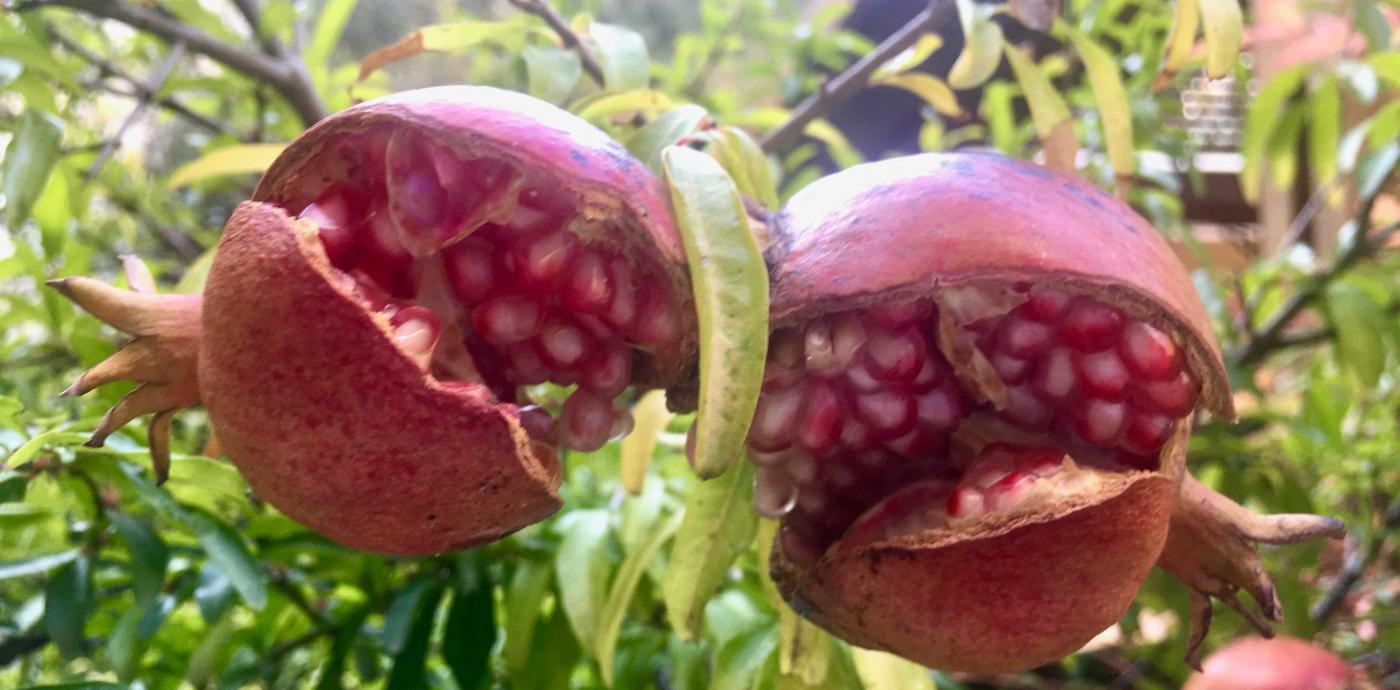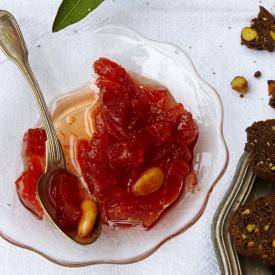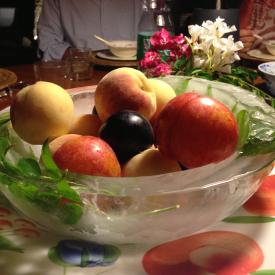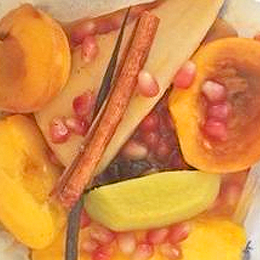Share This
At Oldways, we are often asked to speak about the Mediterranean Diet at conferences, webinars, and other events. When we were asked several years ago to speak with the chefs and management of Senior Living Residences, an assisted living community based in the Boston metro area, we jumped at the chance. We were especially excited and interested because the company had embraced the Mediterranean Diet as the centerpiece of the dining experience for their residents. As they say, “in an effort to continually improve our Mediterranean diet-based Brain Healthy Cooking program, we partner with Oldways.”
At our very first presentation, one of the chefs asked Kelly Toups, Oldways Director of Nutrition and also a dietitian, all about dessert. He said, “our residents love dessert, they look forward to dessert, and while we are aiming for healthy, we also want dessert to be completely delicious. Should we use different sugar? What should we do?”
Kelly’s advice is perfect for everyone, not just seniors. Daily, whole fruit is a perfect dessert —healthy and delicious. For those special days when more is called for, Kelly’s advice is to keep some sugar, and also think about adding nutrition to the dessert. By this, she suggests adding fruit, nuts, whole grains, healthy fats, or even vegetables to make a delicious dessert that also happens to be on the healthier side. Or to go one step further, base desserts around the seasonal fruit you love.
With a virtual tour around the Mediterranean as inspiration, try a sweet fruit treat for your next family get-together or dinner party.
Greece: While you may immediately think of the very sweet, nut- and honey-filled baklava as the typical Greek (or Turkish) dessert, there are many others to sample. Our favorite, which we learned about at an Oldways Symposium on the North Aegean islands of Chios and Lesbos, is spoon sweets or Kydoni Glyko in Greek. Spoon sweets are made by boiling fruit or vegetables, nuts, or flowers in a sugar syrup, and infusing them with spices and herbs, with a consistency much thicker or chunkier than jam or jelly. Spoon sweets are considered a sign of hospitality in Greece, and are served on small plates, with accompanying small spoons –now you can guess why they are called spoon sweets! To make your own, Aglaia Kremezi has a great recipe on her website, Aglaia & Costas’ Table on Kea.
Turkey: We couldn’t decide between two typical desserts— aşure, a porridge of grains, chickpeas, fruit, dried fruit and nuts also called Noah’s pudding or Ayva tatlısı, a quince dessert. Aşure (pronounced AH-SURE-EH) is true comfort food, perfect for breakfast as well as dessert. Its recipe changes from region to region, family to family, and it is a year-round dessert, but is featured prominently during Muharram, the first month of the Islamic calendar. In Turkish, Ayva tatlısı (pronounced EYE-VA TAT-LEH-SEH) means quince dessert, which is served during the quince season from September to January. The quince is peeled, cut in half and then baked for about an hour and a half in the juice of another seasonalfruit, pomegranate, along with sugar and a cinnamon stick. To serve Ayva tatlısı, put the quince on a plate and top with clotted cream, crushed pistachios, or walnuts.
Spain: As in many Mediterranean countries, seasonal whole fruit is what is most often served as dessert, at home and even in restaurants. Although fruit are beautiful on their own, our Spanish friend Mar Luchetti created a spectacular ice bowl to serve fruit at Fausto and Mar Luchetti’s house in Pantelleria, a Mediterranean island between Sicily and Tunisia. To do this, line a clear glass or plastic bowl with slices of fruit, leaves or flowers. Place a smaller bowl on top of the fruit, leaves or flowers, with a weight holding the smaller bowl down firmly. Pour water between the two bowls, up to ½ of the rim. Place the bowls in the freezer, overnight if possible. When you’re almost ready to serve fruit in the bowl, let the bowls thaw for about 15 minutes, until the two bowls separate. Flip over and remove the larger bowl, and then flip it back onto a plate, and take the smaller bowl off. Place the fruit you are serving in the ice bowl and bring to the table!
Back in Madrid, one dessert Mar serves is Fruit in Parchment. Although you may be familiar with fish or chicken baked in parchment, this preparation is perfect for fruit. Make it part of your repertoire—it’s simple, it’s delicious, it’s healthy and it’s beautiful! Mar used mangoes, peaches, pomegranate seeds, melon, plus sticks of cinnamon and vanilla, and a touch of wine.
Italy: Italians know plenty of ways to enjoy fruit at the end of a meal, in addition to whole fruit at the end of a meal, which is usual fare, even if there’s a fancier dessert. Sicilian orange olive oil cake is one of our favorites and meets the approval of our Italian friend Fausto Luchetti, as well as meeting Kelly Toups’ criteria of adding nutrition: a healthy fat (extra virgin olive oil), whole grains (whole grain flour), fruit (orange), and nuts. What’s not to love? Citrus, extra virgin olive oil, a dusting of sugar and crushed almonds. We suggest this recipe, which we adapted from Mark Bittman’s book, How to Cook Everything. If you are looking for something different, try a granita, a semi-frozen dessert originally from Sicily, made from sugar, water and various flavorings, including fruit. We love this recipe for watermelon granita. The watermelon and lemon give this granita a bright, natural flavor.
France: There are plenty of sweets in Provence, a region in France that touches the Mediterranean Sea. Fruit salads are always on the menu, but the words, “fruit” and “France” reminded us of Catherine Katz’ Fresh Fruit Clafoutis or her Fresh Fruit Galette. Catherine and her husband Dr. David Katz traveled with Oldways for a Culinaria in Sicily in 2018. In a cooking class in Ortigia, Catherine taught us how to make the delicious vegan galette, and then repeated it for an Oldways Heritage cooking class (a webinar series) this summer.
Lebanon: Lebanese Fruit Cocktail with Ashta is a very popular street food in Lebanon. It’s made with 4 to 6 different kinds of fresh fruit, strawberry juice and topped with rose water ashta. Ashta is a clotted cream, made by heating milk and cream, with a small amount of lemon juice, and then flavored with rose water. (We’ve read that ricotta can be substituted for ashta, but we expect that doesn’t happen in Beirut!) To assemble the Lebanese Fruit Cocktail, place the cut up whole fruit (bananas, mangoes, kiwis, strawberries, fruit of choice) in a tall glass, add strawberry juice, and then top with ashta, and then drizzle with honey and add chopped walnuts.
Israel: Since journalist, author, and dietitian Rosie Schwartz is a frequent traveler to Israel, we asked Rosie for her favorite Israeli fruit-based dessert. She wrote, “as for fruit desserts in Israel, they are always very seasonal. One of my friends in Jerusalem, Chef Moshe Basson of Eucalyptus restaurant, prepares a delicious dessert— what he calls Israel’s take on peanut butter and jelly. Here’s what he does: he covers a plate with circle of tahini and then forms a spider web- like pattern with date syrup. He then places slices of seasonal fruit around it to dip into the tahini-date syrup mix. At this time of year, it could be persimmons (or Sharon fruit, as it’s called in Israel), apples, or pears with some pomegranate arils sprinkled around. He sometimes adds fingers of plain cake or biscuits alongside.”
Morocco: Paula Wolfert is the true expert on Moroccan food (among other subjects), and so we dove into her ground-breaking book, Couscous and Other Good Food from Morocco, first published in 1973, to get a suggestion of a Mediterranean fruit dessert. The answer is not so simple. In Paula’s words, “The traditional way to end a Moroccan dinner, and the traditional “dessert” also of most North Africans, is a bowl or platter of fruits and nuts. Usually an enormous platter is offered of carefully arranged plums, apricots, bananas, oranges and figs, as well as, on a separate platter, cubed melon. In winter a bowl of raisins, dates, dried figs, almonds, and walnuts may replace the fresh fruits. Other fruit dishes, including Orange Salad with Rosewater or a dessert of pomegranate seeds mixed with almonds, sugar, and orange flower water, may also be offered— and of course, there is always the simple but soothing glass of tea. If this interests you, Saveur magazine’s website has a similar recipe, a dessert of pomegranate seeds and nuts that is adapted from a recipe that appears in the now out-of-print cookbook Seductive Flavours of the Levant.
Egypt: Egyptians have a fancy fruit salad that is similar to the Lebanese fruit cocktail. Also a street food favorite, the Fakhfakhina is of Egyptian origin and is made by layering seasonal fruit, dried fruit, fruit juices, and topped by ice cream, nuts, dates and/or honey. Another Egyptian favorite is Kar Assalay, pumpkin pie without the crust. Most intriguing is the Baked Sweet Potato, a very inexpensive street food that is baked on a cart in a wood-fired oven.
We hope this inspires you to try something new for the holidays. Whatever your fruit pleasure, there are endless possibilities.
Want biweekly Med Diet information and recipes in your Inbox? Sign up for our Fresh Fridays newsletter by clicking the Subscribe button at the bottom of this page!
Join the Make Every Day Mediterranean Club Facebook group for additional information and support.





Comments
Add a Comment